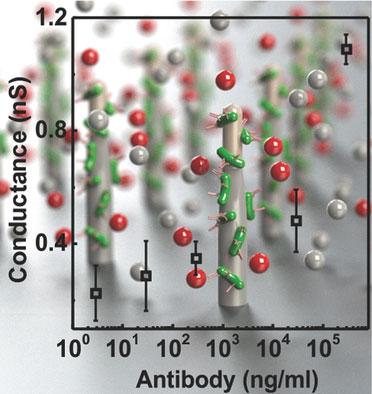| Posted: Feb 17, 2015 |
Label-free electrochemical immunosensor based on functionalized vertical nanowires
|
|
(Nanowerk News) Single-crystal, one-dimensional (1D) nanostructures such as nanowires (NWs) are well known for their excellent electronic transport properties that are not observed in their bulk counterparts. This makes them ideal candidates for manufacturing high-performance electronic devices which are increasingly important to a variety of research areas including chemical and biosensors.
|
|
These electrical properties of NWs are strongly influenced by minor perturbations to surface charge owing to their high surface to volume ratio. Consequently, chemical species binding to the surface of these semiconducting NWs can lead to depletion or accumulation of carriers in the “bulk” of the structure. The changes in electrical properties of the NW are proportional to the concentration of the specific molecule of interest and can be monitored by changes in the conductance and space charge capacitance.
|
|
The surface functionalization of NWs with biomolecules enables stable and novel hybrid systems that utilize the specific recognition or catalytic properties of biomaterials with very low detection limits and good dynamic range of NWs sensors. This has led to much research activity towards the development of semiconducting Si NW as ultra small-dimensional devices for intracellular recording applications.
|
|
Conventional methods for generation of electrochemical biosensors rely solely on the measurement of currents and/or voltages to detect biochemical binding include impedance spectroscopy, cyclic voltammetry, potentiometry, and pulsed amperometry.
|
 |
| The vertical nanowires are functionalized to detect antibodies against a major astrocytic structural protein component, glial fibrillary acidic protein (GFAP). It is revealed that the interaction of GFAP-antibody with functionalized vertical nanowires leads to a clear change in device conductance and the corresponding capacitance.
|
|
In a new paper in Small ("Vertical Nanowire Electrode Arrays as Novel Electrochemical Label-Free Immunosensors"), researchers from The University of Melbourne propose a label-free electrochemical immunosensor based on functionalized vertical nanowire (VNW) by means of a current patch clamp amplifi er which has not been previously reported.
|
|
Importantly, this paper opens up a new field of research, where VNW electronics are merged with biological systems for unconventional applications such as measuring protein levels directly inside a living cell.
|

